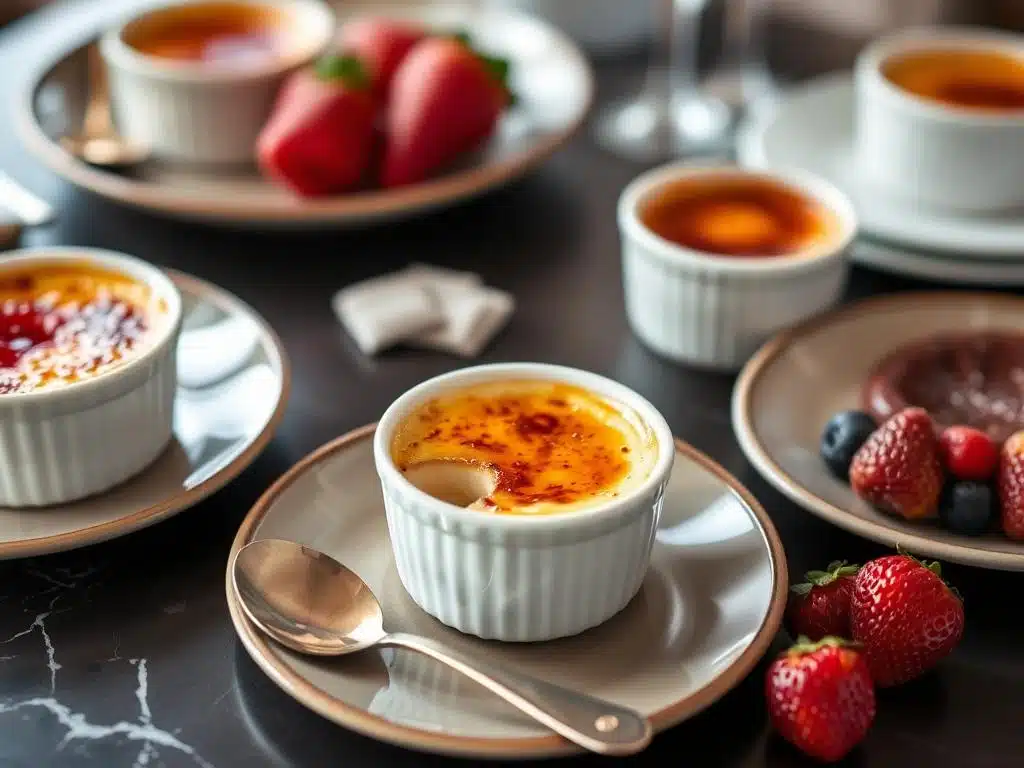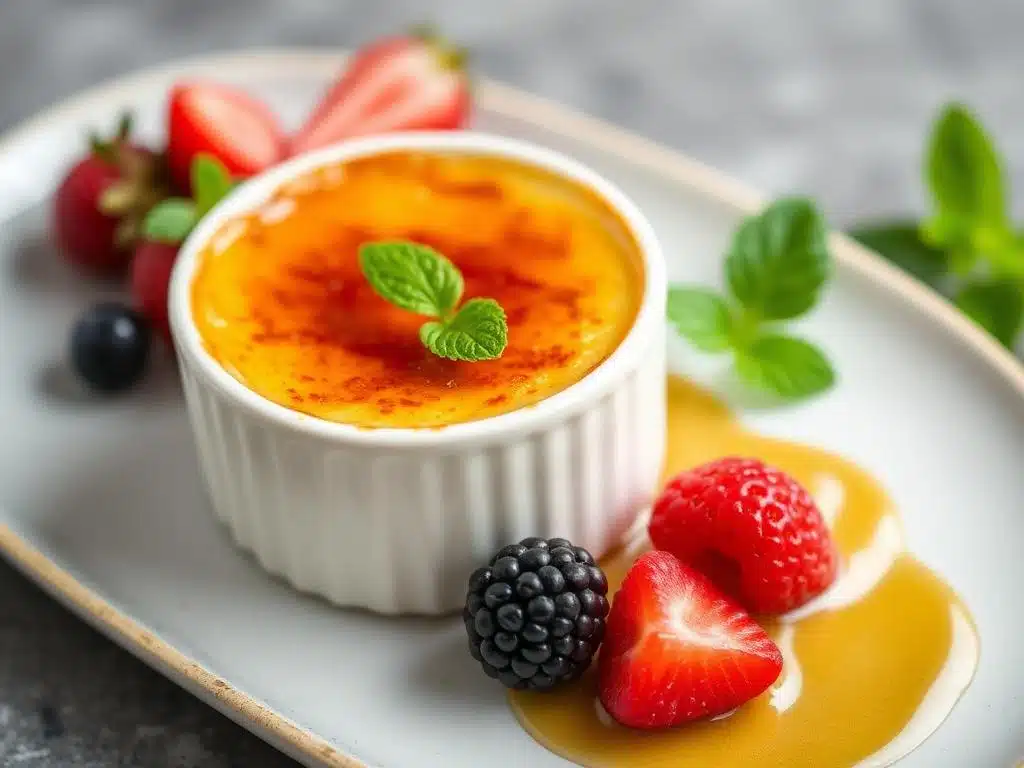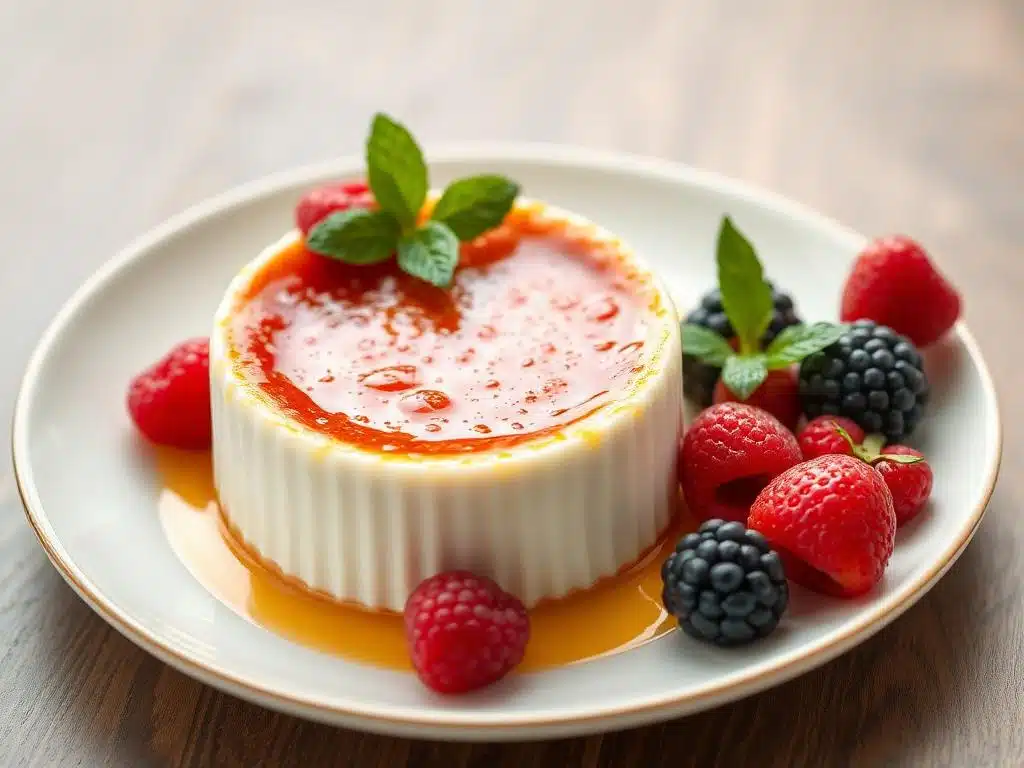Crème brûlée, a classic French dessert, is a delightful combination of creamy custard topped with a layer of hard caramel. It’s a dish that has captured the hearts of many dessert lovers around the world. But what is the secret to achieving that perfect balance of smooth custard and crunchy caramelized sugar? In this article, we’ll explore the essential ingredients, techniques, and common pitfalls to avoid, ensuring you can create a crème brûlée that impresses every time. Let’s dive into the world of this exquisite dessert! to cover the Crème Brûlée secret.
Introduction to Crème Brûlée secret
What is Crème Brûlée?
At its core, crème brûlée is a rich custard dessert that features a unique texture and flavor profile. The base is made from heavy cream, egg yolks, and sugar, which are combined and baked until they form a silky smooth custard. The pièce de résistance, however, is the caramelized sugar topping, which adds a delightful crunch and a hint of bitterness that perfectly complements the sweetness of the custard.
This dessert is often served in individual ramekins, making it a popular choice for dinner parties and special occasions. The contrast between the creamy custard and the crispy sugar layer is what makes crème brûlée a standout dessert.
The History of Crème Brûlée
The origins of crème brûlée are somewhat murky, with several countries claiming to have invented this delectable treat. While it’s widely recognized as a French dessert, some food historians trace its roots back to England, where a similar dish called “Trinity Cream” was served at Trinity College, Cambridge, in the 17th century.
However, the name “crème brûlée” itself translates to “burnt cream” in French, which refers to the method of caramelizing the sugar on top. This technique has been perfected over the years, leading to the rich and creamy version we know today.
In France, crème brûlée has become a staple in many restaurants and is often featured on dessert menus. Its popularity has spread globally, inspiring countless variations and adaptations. Whether you’re enjoying a classic vanilla version or experimenting with unique flavors, the allure of crème brûlée remains timeless.
As we move forward, we’ll uncover the essential ingredients that make this dessert so special, as well as the techniques that will help you master the art of crème brûlée. So, let’s get started!
The Essential Ingredients
To create the perfect crème brûlée, understanding the essential ingredients is crucial. Each component plays a significant role in achieving that rich, creamy texture and the delightful caramelized topping. Let’s break down the key ingredients that make this dessert a true masterpiece.
The Base Ingredients
Heavy Cream
The star of the show in any crème brûlée recipe is undoubtedly the heavy cream. This ingredient provides the rich, velvety texture that makes the custard so indulgent. When heated, heavy cream transforms into a luscious base that blends beautifully with the egg yolks and sugar.
For the best results, opt for high-quality heavy cream with a fat content of at least 36%. This ensures a creamy consistency that’s essential for a successful crème brûlée.
Egg Yolks
Egg yolks are another vital ingredient in crème brûlée. They contribute to the custard’s richness and help create that smooth, silky texture. The proteins in the yolks also act as a thickening agent when cooked, giving the custard its characteristic body.
Typically, a recipe will call for about four to six egg yolks, depending on the quantity you’re making. Remember, using fresh eggs will yield the best flavor and texture.
Sugar
Sugar is essential for sweetening the custard and creating that delightful caramelized topping. Granulated sugar is the most common choice, but you can also experiment with other types, such as brown sugar, for a deeper flavor.
When making crème brûlée, it’s important to balance the sweetness of the custard with the bitterness of the caramelized sugar. This contrast is what makes each bite so enjoyable.
Vanilla Bean vs. Extract
Vanilla is the flavor backbone of traditional crème brûlée. You can use either vanilla beans or vanilla extract, but each option offers a different experience.
Using a vanilla bean will give your custard a more intense flavor and beautiful specks of vanilla throughout. Simply split the bean and scrape out the seeds, adding them to the cream as it heats. On the other hand, vanilla extract is a convenient alternative that still provides a lovely flavor, though it may not be as robust as using the whole bean.
Optional Ingredients for Flavor
While the classic crème brûlée is delicious on its own, you can elevate the flavor profile by incorporating optional ingredients.
Citrus Zest
Adding a hint of citrus zest, such as lemon or orange, can brighten the flavor of your custard. Just a teaspoon of zest mixed into the cream can add a refreshing twist that complements the richness of the dessert.
Liqueurs
For those looking to experiment, a splash of liqueur can add depth to your crème brûlée. Consider using flavors like almond or coffee liqueur to create a unique variation. Just be cautious not to overpower the delicate balance of flavors.
Spices
Spices like cinnamon or nutmeg can also be incorporated for a warm, aromatic touch. A pinch of these spices can transform your crème brûlée into a cozy dessert, perfect for colder months.
The Secret Techniques
Now that we’ve covered the essential ingredients for a perfect crème brûlée, it’s time to explore the secret techniques that will elevate your dessert to the next level. Mastering these methods will ensure that your custard is smooth, creamy, and topped with a perfectly caramelized sugar layer. Let’s dive into the details!
The Importance of Temperature Control
Cooking Temperature
One of the most critical aspects of making crème brûlée is controlling the cooking temperature. The custard should be baked gently to avoid curdling the eggs. Ideally, you want to cook it at a low temperature, around 325°F (160°C).
Using a thermometer can help you monitor the temperature of the custard as it cooks. When done correctly, the custard should be set around the edges but still slightly jiggly in the center. This ensures a silky texture once it cools and firms up in the refrigerator.
Cooling Process
After baking, the cooling process is just as important. Allow the crème brûlée to cool at room temperature for about 30 minutes before transferring it to the refrigerator. Chilling the custard for at least two hours (or overnight) helps it set properly and enhances the flavors.
Remember, patience is key! Rushing this step can lead to a less-than-perfect texture.
The Role of Bain-Marie
What is a Bain-Marie?
A bain-marie, or water bath, is a technique used to create a gentle cooking environment for delicate dishes like crème brûlée. This method helps distribute heat evenly, preventing the custard from cooking too quickly or unevenly.
To set up a bain-marie, place your ramekins filled with custard into a larger baking dish. Then, fill the baking dish with hot water until it reaches halfway up the sides of the ramekins. This water bath will help regulate the temperature as the custard bakes.
How to Set Up a Bain-Marie for Crème Brûlée
- Preheat your oven to 325°F (160°C).
- Prepare your crème brûlée mixture and pour it into individual ramekins.
- Place the ramekins in a large baking dish.
- Carefully pour hot water into the baking dish, ensuring it reaches halfway up the sides of the ramekins.
- Bake until the custard is set around the edges but still slightly jiggly in the center, about 30-40 minutes.
Using a bain-marie is a game-changer for achieving that perfect custard texture, so don’t skip this step!
Achieving the Perfect Caramelized Sugar Top
Using a Kitchen Torch
The crowning glory of crème brûlée is the caramelized sugar topping. One of the best ways to achieve this is by using a kitchen torch. Here’s how to do it:
- Once your custard has chilled, sprinkle an even layer of granulated sugar over the top.
- Ignite your kitchen torch and hold it about 2-3 inches above the sugar.
- Move the torch in a circular motion, allowing the heat to melt the sugar evenly.
- Continue until the sugar turns a deep amber color and forms a hard crust.
Using a kitchen torch gives you precise control over the caramelization process, resulting in a beautifully crisp topping.
Oven Broiling Method
If you don’t have a kitchen torch, don’t worry! You can also achieve a caramelized topping using your oven’s broiler. Here’s how:
- Preheat your broiler.
- Sprinkle an even layer of sugar over the chilled custard.
- Place the ramekins on a baking sheet and position them under the broiler.
- Keep a close eye on them, as the sugar can burn quickly. Broil for about 1-2 minutes, or until the sugar is melted and bubbly.
This method is effective, but it requires more attention to prevent burning.
With these techniques in your arsenal, you’re well-equipped to create a stunning crème brûlée that will impress your guests. Next, we’ll discuss common mistakes to avoid when making this classic dessert, ensuring your efforts yield the best results.
For those who love diving into culinary delights, crème brûlée is just one of many fascinating dishes to explore. Curious about other creamy indulgences? Check out What Is Considered Sweet Cream? for an introduction to this versatile ingredient or explore Sweet Cream Butter: What It Is, How It’s Made, and Why It’s Unique for insights into a luxurious addition to desserts. Additionally, if you’re perfecting your cream-based recipes, How to Make Cream Cheese Filling Thicker provides helpful tips for achieving the ideal texture. These articles can elevate your culinary adventures!
Common Mistakes to Avoid

Even the most seasoned bakers can run into trouble when making crème brûlée. To help you achieve that perfect custard and caramelized topping, let’s explore some common mistakes and how to avoid them. By steering clear of these pitfalls, you’ll be well on your way to mastering this classic dessert.
Overcooking the Custard
One of the biggest mistakes you can make when preparing crème brûlée is overcooking the custard. If you cook it for too long or at too high a temperature, the eggs can curdle, resulting in a grainy texture instead of the smooth, silky custard you desire.
To avoid this, always keep an eye on the cooking time and temperature. Remember, the custard should be set around the edges but still slightly jiggly in the center when you take it out of the oven. If you’re unsure, using a thermometer can help; the internal temperature should be around 170°F (77°C) when done.
Incorrect Sugar Caramelization
Another common issue arises during the caramelization process. Whether you’re using a kitchen torch or the broiler, it’s easy to burn the sugar if you’re not careful. Burnt sugar not only tastes bitter but also ruins the overall presentation of your crème brûlée.
To prevent this, sprinkle an even layer of sugar over the custard, ensuring it’s not too thick. When using a kitchen torch, keep it moving in a circular motion to distribute the heat evenly. If you’re broiling, stay close and watch the sugar closely, as it can go from perfectly caramelized to burnt in seconds.
Skipping the Chilling Step
Chilling the custard is a crucial step that some may be tempted to skip in the name of expediency. However, this step is essential for achieving the right texture and flavor. If you don’t allow the crème brûlée to chill properly, it may not set correctly, resulting in a runny custard.
Make sure to chill your crème brûlée for at least two hours, or even overnight if possible. This not only helps the custard firm up but also allows the flavors to meld beautifully.
Not Using Fresh Ingredients
Using fresh ingredients is key to creating a delicious crème brûlée. Old or expired cream, eggs, or vanilla can negatively impact the flavor and texture of your dessert. Always check the freshness of your ingredients before you start cooking.
For the best results, opt for high-quality heavy cream and fresh eggs. If you’re using vanilla beans, make sure they’re fragrant and pliable. Fresh ingredients will elevate your crème brûlée and make a noticeable difference in taste.
Variations of Crème Brûlée

While the classic vanilla crème brûlée is a timeless favorite, there are countless variations that can add a unique twist to this beloved dessert. Whether you’re looking to impress guests or simply want to try something new, these variations will inspire your culinary creativity. Let’s explore some delicious options!
Classic Vanilla Crème Brûlée
The traditional vanilla crème brûlée is a staple for a reason. Its rich, creamy custard infused with real vanilla bean creates a luxurious dessert that’s hard to resist. To make this classic version, simply follow the basic recipe using heavy cream, egg yolks, sugar, and vanilla beans.
The key to a perfect vanilla crème brûlée lies in the quality of the vanilla. Using fresh vanilla beans will give you the best flavor and those beautiful specks that make the dessert visually appealing.
Chocolate Crème Brûlée
For chocolate lovers, a chocolate crème brûlée is a decadent twist on the classic recipe. By adding high-quality chocolate to the custard mixture, you can create a rich and indulgent dessert that satisfies any sweet tooth.
To make chocolate crème brûlée, simply melt about 4 ounces of dark chocolate and whisk it into the warm cream before combining it with the egg yolks and sugar. This will create a luscious chocolate custard that pairs beautifully with the caramelized sugar topping.
Fruit-Flavored Crème Brûlée
If you’re looking for a refreshing take on crème brûlée, consider incorporating fruit flavors. You can infuse the cream with various fruits, such as berries, mango, or passion fruit, to create a vibrant and fruity custard.
To make a fruit-flavored crème brûlée, puree your chosen fruit and strain it to remove any seeds or pulp. Mix the fruit puree into the cream before heating it. This will give your custard a delightful fruity flavor that contrasts beautifully with the crispy sugar topping.
You can also use citrus zest, like lemon or orange, to add a zesty kick to your crème brûlée. Just remember to balance the sweetness of the fruit with the sugar topping for a harmonious dessert.
With these variations, you can easily customize your crème brûlée to suit your taste or the occasion. Whether you stick with the classic vanilla or venture into chocolate or fruit flavors, each version offers a unique experience that’s sure to delight.
Serving Suggestions and Pairings
Once you’ve mastered the art of making crème brûlée, it’s time to think about how to serve it and what to pair it with. The right presentation and accompaniments can elevate your dessert experience, making it even more memorable. Let’s explore some ideal serving suggestions and beverage pairings that will complement your delicious crème brûlée.
Ideal Serving Temperature
The perfect serving temperature for crème brûlée is crucial for enjoying its rich flavors and textures. After chilling the custard in the refrigerator, it’s best to let it sit at room temperature for about 10-15 minutes before serving. This slight warming allows the custard to soften just a bit, enhancing the creamy mouthfeel.
When you’re ready to serve, make sure the caramelized sugar topping is freshly torched or broiled. This will ensure that the sugar is crisp and crackly, providing that delightful contrast to the smooth custard beneath.
For an elegant presentation, serve the crème brûlée in individual ramekins, and consider garnishing with a sprig of mint or a few fresh berries on the side. This adds a pop of color and freshness to the dish.
Beverage Pairings
Pairing your crème brûlée with the right beverage can enhance the overall dining experience. Here are some delightful options to consider:
Coffee
A rich cup of coffee is a classic pairing for crème brûlée. The bold flavors of coffee complement the sweetness of the custard, creating a harmonious balance. Whether you prefer espresso, cappuccino, or a simple black coffee, this combination is sure to please.
Herbal Tea
For a lighter option, consider serving your crème brûlée with a cup of herbal tea. Flavors like chamomile, mint, or even a citrus-infused tea can provide a refreshing contrast to the richness of the dessert. The warmth of the tea will also enhance the overall experience.
Sparkling Water
If you’re looking for a non-caffeinated option, sparkling water is a great choice. The effervescence of the bubbles can cleanse the palate between bites, allowing you to fully appreciate the flavors of the crème brûlée. You can even add a slice of lemon or lime for a hint of citrus.
Fruit Juices
Fresh fruit juices, such as orange or berry juice, can also pair nicely with crème brûlée. The natural sweetness and acidity of the juice can complement the dessert, making for a refreshing combination.
FAQs about Crème Brûlée secrets
As you embark on your journey to create the perfect crème brûlée, you may have some questions. This section addresses common queries that many home bakers have about this classic dessert. Let’s dive into these frequently asked questions to help you achieve the best results!
What is the best way to store crème brûlée?
Storing crème brûlée properly is essential to maintain its texture and flavor. After preparing your custard, it’s best to chill it in the refrigerator for at least two hours or overnight.
Once the custard is set, cover the ramekins with plastic wrap or a lid to prevent any odors from the fridge from affecting the flavor. However, avoid covering the caramelized sugar topping, as it can become soggy.
If you have leftover crème brûlée, it’s best to store the custard and the sugar topping separately. You can reheat the custard gently before adding a fresh layer of sugar and caramelizing it again for serving.
Can you make crème brûlée in advance?
Absolutely! Crème brûlée is an excellent dessert to prepare in advance. You can make the custard a day or two ahead of time, allowing it to chill in the refrigerator until you’re ready to serve.
Just remember to caramelize the sugar topping right before serving. This ensures that the sugar remains crisp and adds that delightful crunch to each bite. Preparing in advance not only saves time but also allows the flavors to meld beautifully.
What is the difference between crème brûlée and other custards?
While crème brûlée is a type of custard, it has some distinct characteristics that set it apart from other custard desserts. The primary difference lies in the preparation and presentation.
Crème brûlée is baked in individual ramekins and features a hard caramelized sugar topping, which is achieved through torching or broiling. Other custards, like flan or panna cotta, may not have this crispy layer and can be served in different forms, such as unmolded or set in a mold.
Additionally, crème brûlée typically has a higher fat content due to the use of heavy cream, resulting in a richer and creamier texture compared to other custards.
How do you know when crème brûlée is done?
Determining when your crème brûlée is done can be a bit tricky, but there are a few key indicators to look for.
First, check the edges of the custard; they should be set and firm. Gently jiggle the ramekin; the center should still have a slight wobble but not be liquid. If it’s too jiggly, it likely needs more time in the oven.
Using a thermometer can also help; the internal temperature should reach around 170°F (77°C) when fully cooked. Remember, the custard will continue to set as it cools, so it’s better to err on the side of slightly undercooking than overcooking.
Conclusion
The Secrets to Perfect Crème Brûlée
In this comprehensive guide, we’ve uncovered the secrets to creating the perfect crème brûlée. From understanding the essential ingredients–like heavy cream, egg yolks, and sugar–to mastering the techniques of temperature control and using a bain-marie, each step is crucial in achieving that rich, creamy custard topped with a delightful layer of caramelized sugar.
We’ve also explored common mistakes to avoid, such as overcooking the custard and improperly caramelizing the sugar. By steering clear of these pitfalls, you can ensure that your crème brûlée turns out beautifully every time.
Additionally, we’ve discussed various delicious variations, serving suggestions, and beverage pairings that can elevate your dessert experience. Whether you stick with the classic vanilla or venture into chocolate or fruit flavors, there’s a world of possibilities to explore.
Experiment with Flavors
Now that you have the knowledge and techniques to create a stunning crème brûlée, don’t hesitate to experiment with flavors and presentations. The beauty of this dessert lies in its versatility. You can customize it to suit your taste or the occasion, making it a delightful treat for any gathering.
So, gather your ingredients, fire up your kitchen torch, and get ready to impress your friends and family with your culinary skills. With practice and creativity, you’ll soon be known as the crème brûlée expert among your peers!
Happy baking, and enjoy every delicious bite of your homemade crème brûlée!

